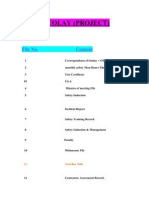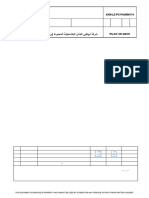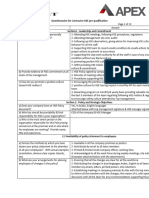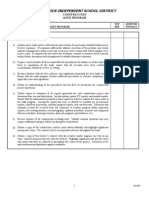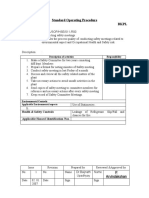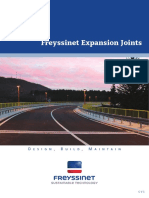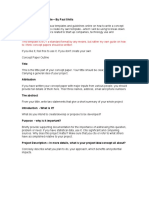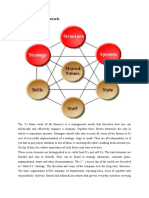02 - SOP On Incident Reporting, Investigation & Record Procedure
02 - SOP On Incident Reporting, Investigation & Record Procedure
Uploaded by
Zain TahirCopyright:
Available Formats
02 - SOP On Incident Reporting, Investigation & Record Procedure
02 - SOP On Incident Reporting, Investigation & Record Procedure
Uploaded by
Zain TahirOriginal Title
Copyright
Available Formats
Share this document
Did you find this document useful?
Is this content inappropriate?
Copyright:
Available Formats
02 - SOP On Incident Reporting, Investigation & Record Procedure
02 - SOP On Incident Reporting, Investigation & Record Procedure
Uploaded by
Zain TahirCopyright:
Available Formats
Date: 14/10/13 Revision No.
: 00
Issued by: VS Page No.: Page 1 of 8
Safe Operating Incident Reporting, Investigation & Ref No.: GPL/SAF/SOP-II/IR/R0
Procedure (SOP) Record procedure
Safe Operating Procedure
On Incident Reporting, Investigation & Record procedure
1. Purpose:
The purpose of this safe operating procedure (SOP) is to define the framework and protocol for
incident reporting and investigation. The SOP provides incident reporting and investigation formats
to assist effective investigation, root cause analysis and to identify corrective and preventive
measures.
2. Scope:
The safe operating procedure (SOP) will be applicable to all current and upcoming projects of GPL
and relevant stakeholders which are likely to be affected directly or indirectly by impact of the
occurrence of incident.
3. Roles & Responsibility:
GPL Project Manager is responsible for adherence to the safe operating procedure (SOP) through
PMC & responsible contractors. And the respective Contractor is responsible to transmit this SOP to
their sub-contractors and ensure that the contents are clearly understood by them.
4. Definitions/ Abbreviations:
Definitions: (as per BOCW and IS 3786)
Fatal/Total Permanent Disability: Loss of life / bodily injury, which may permanently, disables
a person to carry on his daily work.
Incident: Work related events in which an injury or ill health or fatality occurred or could have
occurred.
Reportable Incident: Disable a person from working for a period of forty-eight hours or more
immediately following the incident.
Man-days Lost: Working man-days lost due to reportable accidents (excluding day of
accident). Consider 6000 man-days lost for each death / total permanent disability.
Near-Miss: An incident where person escaped from injury, ill health or fatality.
Dangerous Occurrences: As per BOCW Rules following classes of incidents are classified as
dangerous occurrences & shall be reported, whether or not any injury, disablement or death
caused to the worker, namely:
a) Collapse or failure of lifting appliances, or hoist, or conveyors, or similar equipment for
handling of building or construction material or breakage or failure of rope, chain or loose gears;
or overturning of cranes used in construction work;
b) Falling of objects from height;
c) Collapse or subsidence of soil, tunnel, pipe lines, any wall, floor, gallery, roof or any other part
of any structure, launching girder, platform, staging, scaffolding or means of access including
formwork;
d) explosion of receiver or vessel used for storage of pressure greater than atmospheric
pressure, of any gas or gases or any liquid or solid used as building material;
e) Fire and explosion causing damage to any place on construction site where building workers
are employed;
f) Spillage or leakage of any hazardous substance and damage to their container;
Prepared by: RM Reviewed by: VS Approved by: JP
Date: 14/10/13 Revision No.: 00
Issued by: VS Page No.: Page 2 of 8
Safe Operating Incident Reporting, Investigation & Ref No.: GPL/SAF/SOP-II/IR/R0
Procedure (SOP) Record procedure
g) Collapse, capsizing, toppling or collision of transport equipment;
h) Leakage or release of harmful toxic gases at the construction site;
j)In case of failure of launching girder, lifting appliance, loose gear, hoist or building and other
construction work, machinery and transport equipment at a construction site, such appliances,
gear, hoist, machinery or equipment and the site of such occurrence shall, as far as practicable,
be kept undisturbed until inspected by the Authorities;
First Aid Injury: This is the provision of initial care for an illness or injury, which may not
require further medical care.
Accident: An unintended occurrence arising out of and in the course of employment of a
person resulting in injury.
Ill Health: Identifiable, adverse physical or mental condition arising from and / or made worse
by a work activity and / or work related situation.
Lost Time Injury: An injury causing disablement extending beyond the day of shift on which
the accident occurred.
Abbreviations:
BOCW: The Building & Other Construction Workers (Regulation of Emp & Conditions of
Service) Act, 1996 and Rules 1998.
HIRA: Hazard Identification & Risk Assessment
PMC: Project Management Consultant
PPE: Personal protective equipment
FIR: First Information Report
5. Legal:
The Building & other Construction Workers (Regulation of Emp& Conditions of Service) Act,
1996.
The Building & other Construction Workers (Regulation of Emp& Conditions of Service) Central
Rules, 1998.
BOCW Rule – 210, 211
IS 3786
6. Procedure:
6.1 Incident Reporting:
It is the responsibility of every employee at site whether belongs to contractor, sub-contractor,
PMC’s, GPL and visitors if notices any incident, first-aid ,encounter any type of near miss, any
underlying unsafe situation/ behavior having potential to cause injury, fire, property damages,
environmental damages, unhygienic condition, or any other situation which may derail safety,
security or progress of the project etc, shall report the same immediately to GPL Project Manager or
site safety officer verbally, telephonically, by email or through colleague.
Incident reporting hierarchy and communication/ reporting time frame is as follows, which should be
religiously followed.
Prepared by: RM Reviewed by: VS Approved by: JP
Date: 14/10/13 Revision No.: 00
Issued by: VS Page No.: Page 3 of 8
Safe Operating Incident Reporting, Investigation & Ref No.: GPL/SAF/SOP-II/IR/R0
Procedure (SOP) Record procedure
Type Of Reporting To Whom Time Line Reporting Reporting To Mode Of
Incident Authority To Report To Report To RH & GOVT. Communication
HO By Authority as
GPL per rule-210
Project BOCW
Manager
Fatal (Rule 210- Project Project Immediately RH/ DRH; By contractor By phone / mail /
BOCW ) Manager Manager / within 2 COO; HR within 4 hrs. through
of GPL hours of Head; ED; after consent messenger or
Contractor Incident Media of GPL In mode of any
Head and Form No XIV. fastest
Safety communication.
Head Followed by IR
(Incident
Report ) and
Investigation
Report
Reportable Project Project Within 4 RH/ DRH; By contractor By phone / mail /
Injury disabling Manager Manager hours of COO; HR within 72 hrs. / written report.
workers from of GPL Incident Head ; ED; after consent Followed by IR
working for a Contractor Media with GPL (Incident
period of 48 Head and Form No - XIV Report ) and
hours or more Safety Investigation
(Rule 210- Head Report
BOCW ) and
non-reportable
but medical
treatment
injury
Dangerous Project Project Immediate/ RH/DRH & By contractor By phone / mail /
Occurrence as Manager Manager within 4 Region within 72 hrs. / written report.
per Rule 210 (5) of GPL hours of Safety & after consent Followed by IR
– BOCW), Contractor incident. HO Safety with GPL (Incident
Including fire Head Form No - XIV Report ) and
Investigation
Report
Environmental Project Project Immediate/ RH/DRH, By contractor By phone / mail /
Incident Manager Manager within 4 Region within 72 hrs. / written report.
(Leakage of of GPL hours of Safety & after consent Followed by
flammable, Contractor incident. HO Safety with GPL IR(Incident
toxic gases and Head Form No - XIV Report) and
liquids etc.) Investigation
Report
Near Miss Project Project Within 24 RH/DRH & Written report &
Incidents Manager Manager hours. Region Investigation
of GPL Safety Report
Contractor Head
First aid cases Project Project Weekly RH/DRH & Written report &
Manager Manager Basis with Region Investigation
of GPL analysis Safety Report
Contractor Head
Occupational Project Project As an when RH/DRH & Form No – XIII Written report &
Illness Manager Manager noticed Region Investigation
of GPL Safety Report
Contractor Head
Prepared by: RM Reviewed by: VS Approved by: JP
Date: 14/10/13 Revision No.: 00
Issued by: VS Page No.: Page 4 of 8
Safe Operating Incident Reporting, Investigation & Ref No.: GPL/SAF/SOP-II/IR/R0
Procedure (SOP) Record procedure
6.2 Investigation :
i. Investigations should be conducted in an open and positive atmosphere that encourages the
witnesses to talk freely. The primary objective is to ascertain the facts with a view to prevent
future and possibly more serious occurrences.
ii. Incidents and Dangerous Occurrences which result in death, serious injury or serious damage
must be investigated by the Contractor immediately to find out the cause of the
accident/occurrence so that corrective & preventive measures can be formulated to prevent
any recurrence or occurrence.
iii. Near misses and minor accidents should also be investigated by the Contractor as soon as
possible as they are signals that there are inadequacies in the safety management system.
6.2.1 Procedure / Approach of Incident Investigation:
i. It is important after any accident or dangerous occurrence that information relating to the incident
is gathered in an organized way. The following steps shall be followed;
a) Take photographs and make sketches
b) Examine involved equipment, work piece or material and the environmental conditions
c) Interview the injured, eye-witnesses and other involved parties
d) Consult expert opinion where necessary
e) Identify the specific contractor or sub-contractor involved.
ii. Having gathered information, it is then necessary to make an analysis of incident
a) Establish the chain of events leading to the accident or incident
b) Find out at what stage the incident took place
c) Consider all possible causes and the interaction of different factors that led up to the accident,
and identify the most probable cause, the cause of an accident should never be classified as
carelessness. The specific act or omission that caused the accident must be identified
iii. The next stage is to proceed with the follow-up action
a) Report on the findings and conclusions
b) Formulate preventive measures to avoid recurrence
c) Publicizes the findings and the remedial actions taken.
Prepared by: RM Reviewed by: VS Approved by: JP
Date: 14/10/13 Revision No.: 00
Issued by: VS Page No.: Page 5 of 8
Safe Operating Incident Reporting, Investigation & Ref No.: GPL/SAF/SOP-II/IR/R0
Procedure (SOP) Record procedure
Incident investigation hierarchy, communication of outcome and time frame to complete investigation
is as follows, which should be religiously followed:
Type Of Incident Responsibility of Time Submission Responsibility
Investigation Frame Of OF Corrective
Contractor PMC/GPL Investigation and Preventive
Action
Fatal (Rule 210- Contractor Joint Team by Within 48 RH/ DRH; GPL Project
BOCW ) Project Project hours of COO; HR Manager &
Manager Manager of incident Head; ED and Region Head
PMC / GPL , HO - Safety
Region Safety & Head
HO-Safety
Reportable Injury Contractor Joint Team by Within 72 RH/ DRH; GPL Project
disabling workers from Project Project hours of COO; HR Head Manager &
working for a period of Manager Manager of incident ; ED and HO- Region Head
48 hours or more (Rule PMC / GPL & Safety Head
210- BOCW ) and non- Region Safety
reportable but medical
treatment injury
Dangerous Occurrence Contractor Joint Team by Within 72 RH/DRH & HO GPL Project
as per Rule 210 (5) – Project Project hours of Safety Head Manager &
BOCW), Including Fire Manager Manager of incident Region Head
PMC / GPL &
Region Safety
Environmental Incident Contractor Joint Team by Within 72 RH/DRH & HO GPL Project
(Leakage of flammable, Project Project hours of Safety Head Manager &
toxic gases and liquids Manager Manager of incident Region Head
etc.) PMC / GPL &
Region Safety
Near Miss Incidents Area / Safety Engineer Within 24 RH & Region Project Manager
Section PMC/GPL, hours. Safety Head
Incharge Concerned
Execution
Engineer &
Region Safety
First aid cases Safety Safety Engineer Weekly RH & Region Project Manager
Engineer / PMC / Region Basis with Safety Head & Respective Site
Male Nurse Safety Head analysis Incharge
Occupational Illness Contractor Joint Team by As an RH/DRH & GPL Project
Project Project when Region Safety Manager &
Manager Manager of noticed Head Region Head
PMC / GPL &
Region Safety
Prepared by: RM Reviewed by: VS Approved by: JP
Date: 14/10/13 Revision No.: 00
Issued by: VS Page No.: Page 6 of 8
Safe Operating Incident Reporting, Investigation & Ref No.: GPL/SAF/SOP-II/IR/R0
Procedure (SOP) Record procedure
Note: It is the responsibility of Contractors to inform the local labour commissioner office and other
applicable authorities as per state rules immediately after a Fatality, Serious Injury Accident /incident
or a Dangerous Occurrence.
It is the rule at GPL Projects that every incident whether it is any potential underlying situation, near
miss, medical treatment case, reportable incident or dangerous occurrence shall be reported,
investigated, analyzed and corrective actions are initiated to prevent similar recurrences.
6.3 Reporting to Govt. Authority:
i. In addition to the above verbal and written reporting to the GPL, as per Rule 210 of BOCWR,
notice of any incident to a worker at the building or construction site that:
a) Causes loss of life; or
b) Disables a worker from working for a period of 48 hours or more immediately following the
incident;
c) Shall instantly be sent by telegram, telephone, fax, or similar other means including special
messenger within four hours in case of fatal accidents and 72 hours in case of other
incidents, to:
i. The Regional Labour Commissioner (central and/or state), wherein the contractor has
registered the firm /work.
ii. The board with which the worker involved was registered as a beneficiary;
iii. Director General and
iv. The next of kin or other relative of the worker involved in the accident;
ii. Further, notice of incident shall be sent in respect of an accident which
a) Causes loss of life; or
b) Disables the injured worker from work for more than 10 days to
i) The officer-in-charge of the nearest police station;
ii) The District Magistrate or, if the District Magistrate by order so desires, to
iii) The Sub-Divisional Magistrate
iii. In case of an incident causing minor injury, first-aid shall be administered and the injured
worker shall be immediately transferred to a hospital or other place for medical treatment.
iv. Where any incident causing disablement that subsequently results in death, notice in writing of
such death, shall be sent to the authorities mentioned in clause above within 72 hours of such
death.
6.4 Approval:
The GPL Project Manager will review the Incident Report Form and identifying any further
actions if needed. There will also be a need at this stage to allocate actions for any additional risk
assessments and mitigation measures, which are deemed necessary as a result of the incident.
Once the GPL Project Manager has no concerns with the content of the Incident Report Form it
should be signed.
The completed original Incident Report Form along with all supporting documentation should be
given to GPL Project Manager and Site Safety Engineer. Both will review and approve the
Incident Report Form. GPL reserve the right to add comments and actions. The GPL/ PMC Site
Safety Engineer will monitor the actions and a review of the accident will be given in the Monthly
Safety Committee meeting and documented in monthly statistics reports of the project.
Prepared by: RM Reviewed by: VS Approved by: JP
Date: 14/10/13 Revision No.: 00
Issued by: VS Page No.: Page 7 of 8
Safe Operating Incident Reporting, Investigation & Ref No.: GPL/SAF/SOP-II/IR/R0
Procedure (SOP) Record procedure
6.5 Record Procedure:
All contractors will maintain a total record of all the incidents happened at work places, offices,
labour camp etc. The records should contain the following information: type of incident, number
of persons injured and involved, nature of injury, cause of incident, actual activity leading to
incident, possible immediate cause, root cause, investigation of finding, remedial action,
comments , approved by, date prepared and submitted to GPL/PMC Site management, accepted
by GPL/ PMC Site management etc.
7. Incident Reporting Hierarchy :
Contractor Project Govt. Authorities
Manager (As per Rule 210 BOCW)
PMC CMC Safety, Head Office
GPL
Project Manager
Regional Head Regional HR Head/ Admin
Media Head COO & ED
/ Dy.RH Safety Head Legal Head
8. References:
i. Contract Document
ii. GPL HSE Guideline
iii. Site EHS Plan
iv. BOCW Act & Rules.
v. OHSAS 18001:2007
9. Incident Report Format:
Prepared by: RM Reviewed by: VS Approved by: JP
Date: 14/10/13 Revision No.: 00
Issued by: VS Page No.: Page 8 of 8
Safe Operating Incident Reporting, Investigation & Ref No.: GPL/SAF/SOP-II/IR/R0
Procedure (SOP) Record procedure
Prepared by: RM Reviewed by: VS Approved by: JP
You might also like
- PC Pump Manual (En)Document20 pagesPC Pump Manual (En)c.valderrabano81No ratings yet
- HSE SOP (Standard Operating Procedure For HSE Dept) - IEP - HSE - SOP - V.01-05.2022Document2 pagesHSE SOP (Standard Operating Procedure For HSE Dept) - IEP - HSE - SOP - V.01-05.2022Joel JoyNo ratings yet
- Accident Reporting Procedure 1Document2 pagesAccident Reporting Procedure 1Marven JuadiongNo ratings yet
- Premala Hse ManualDocument7 pagesPremala Hse ManualLuqman Osman100% (1)
- BijoynagarDocument21 pagesBijoynagarIndrajit MedhiNo ratings yet
- Pakistan Violence Versus StabilityDocument217 pagesPakistan Violence Versus StabilityAfPakWars100% (2)
- Lessons From AccidentsDocument4 pagesLessons From Accidentsliveconnectionz282No ratings yet
- HS05-Site Induction (Version 1)Document3 pagesHS05-Site Induction (Version 1)Andriy TrukhinNo ratings yet
- ASMI-OSHMS-PR-11 - Communication and Consultation ProcedureDocument6 pagesASMI-OSHMS-PR-11 - Communication and Consultation ProcedureJHUPEL ABARIALNo ratings yet
- MOEM Company Profile - DOSHDocument7 pagesMOEM Company Profile - DOSHPHH9834No ratings yet
- 1.1-QHSE Policy StatementDocument3 pages1.1-QHSE Policy Statementakv9005No ratings yet
- SSP-CRCO-SS05-SYSW-PRO-00119 - 04 - PAT Procedure For 750V DC Earth SwitchDocument31 pagesSSP-CRCO-SS05-SYSW-PRO-00119 - 04 - PAT Procedure For 750V DC Earth Switchabu bakar100% (1)
- Hse ProceduresDocument22 pagesHse ProceduresBrain Dee Tech LtdNo ratings yet
- Accident Incident Reporting Procedure 1719013603Document26 pagesAccident Incident Reporting Procedure 1719013603mata manuelNo ratings yet
- HSE Management System ArenscoDocument22 pagesHSE Management System ArenscoJaber AmariNo ratings yet
- SEC 8 (2) (I) SUPERVISOR APPOINTMENTDocument2 pagesSEC 8 (2) (I) SUPERVISOR APPOINTMENTLwandziso Dlamini100% (2)
- Environment Aspects Procedure: Dr. Concrete Building MaterialDocument6 pagesEnvironment Aspects Procedure: Dr. Concrete Building Materialsudeesh kumarNo ratings yet
- Safety FileDocument1 pageSafety FileSaikat RamNo ratings yet
- Understanding Hse Key Performance IndicatorsDocument6 pagesUnderstanding Hse Key Performance IndicatorsIsaac KobiNo ratings yet
- Title: Smoke Free Policy Guidelines For Bhci: 1. Absolute Prohibition of SmokingDocument2 pagesTitle: Smoke Free Policy Guidelines For Bhci: 1. Absolute Prohibition of SmokingMarti GregorioNo ratings yet
- Oman HSECultureDocument19 pagesOman HSECulturesamsoom1972No ratings yet
- HS 031 Internal AuditDocument16 pagesHS 031 Internal AuditgrantNo ratings yet
- Alcohol Drugs PolicyDocument11 pagesAlcohol Drugs PolicyJBOOTHYNo ratings yet
- Our Code of ConductDocument14 pagesOur Code of ConductEdwin HarsigaNo ratings yet
- Plant and Vicinity Checklists PDFDocument2 pagesPlant and Vicinity Checklists PDFmj santosNo ratings yet
- SHE-ECP-09-013 Portable Electrical Equipment Procedure Rev02Document5 pagesSHE-ECP-09-013 Portable Electrical Equipment Procedure Rev02grantNo ratings yet
- Bus Transport Agreement (Lakshmi)Document4 pagesBus Transport Agreement (Lakshmi)anand kumarNo ratings yet
- Induction ProcedureDocument7 pagesInduction ProcedureHonorable Azeez100% (1)
- Fire Fighter AppointmentDocument2 pagesFire Fighter AppointmentLwandziso Dlamini100% (1)
- Permit To Work (PTW) Procedure Pu-Sy-107-00101 - LDocument69 pagesPermit To Work (PTW) Procedure Pu-Sy-107-00101 - LAgathiyan MechaicalNo ratings yet
- F003B BMC Safety Committee Meeting MinutesDocument1 pageF003B BMC Safety Committee Meeting MinutesShahlaNo ratings yet
- IMS-PRO-001-VER 01 - Safety Observation ProcedureDocument22 pagesIMS-PRO-001-VER 01 - Safety Observation ProcedureDINESH KUMARNo ratings yet
- 05 Management of ContractorDocument8 pages05 Management of ContractorMuhammad Shiraz KhalidNo ratings yet
- 1-Visitor HSE Orientation Attendance RecordDocument1 page1-Visitor HSE Orientation Attendance RecordFarrukh EjazNo ratings yet
- OSHMS ChecklistDocument76 pagesOSHMS Checklisteliasox123100% (1)
- HSI-Safety Plan-2019Document8 pagesHSI-Safety Plan-2019Arvin Omboy100% (1)
- Health & Safety PolicyDocument16 pagesHealth & Safety PolicymanagerNo ratings yet
- Safety AspectsDocument14 pagesSafety AspectsGanga DaranNo ratings yet
- 3 Legal Compliance PlanDocument4 pages3 Legal Compliance Planshiv kumarNo ratings yet
- Chairperson Appointment TemplateDocument4 pagesChairperson Appointment TemplatemimiNo ratings yet
- HSMC Employee Induction Procedure (Offices)Document3 pagesHSMC Employee Induction Procedure (Offices)Anonymous 4e7GNjzGWNo ratings yet
- NR 7 - Occupational Health Plan - Pcmso - PDFDocument5 pagesNR 7 - Occupational Health Plan - Pcmso - PDFpNo ratings yet
- Emergency and Spill Response Plan - Rev 001Document13 pagesEmergency and Spill Response Plan - Rev 001besongNo ratings yet
- GEANT Anti-Slavery PolicyDocument3 pagesGEANT Anti-Slavery PolicyManel GuitartNo ratings yet
- Effective Occupational Safety and Health Management System: Integration of OHSAS 18001, ILO-OSH 2001, and Or-OshaDocument18 pagesEffective Occupational Safety and Health Management System: Integration of OHSAS 18001, ILO-OSH 2001, and Or-Oshaazniwani83No ratings yet
- Petrojet - APEX Questionnaire For Contractor HSE Pre-QualificationDocument12 pagesPetrojet - APEX Questionnaire For Contractor HSE Pre-QualificationAhmed GaafarNo ratings yet
- Round Rock Independent School District: ConstructionDocument6 pagesRound Rock Independent School District: ConstructionLloyd Tongoona BwakuraNo ratings yet
- HSE Plan and Recommendations For Executing The ProjectDocument5 pagesHSE Plan and Recommendations For Executing The ProjectfarrukhNo ratings yet
- Audit Steps - PHEDocument9 pagesAudit Steps - PHEasghar_rana78No ratings yet
- 7 Steps To Writing A ProcedureDocument4 pages7 Steps To Writing A ProcedureZubair KhanNo ratings yet
- Communication Procedure: Purpose and ApplicationDocument2 pagesCommunication Procedure: Purpose and ApplicationElias JarjouraNo ratings yet
- How To Conduct Workplace Inspections: A Health and Safety Guideline For Your WorkplaceDocument6 pagesHow To Conduct Workplace Inspections: A Health and Safety Guideline For Your WorkplacemashanghNo ratings yet
- Safety Training Attendence List: Umm Wu'Al Phosphate Project U&I Multidiscipline PackageDocument1 pageSafety Training Attendence List: Umm Wu'Al Phosphate Project U&I Multidiscipline PackageJayvee Baradas ValdezNo ratings yet
- CR 8 (1) - Construction Manager - N GovenderDocument1 pageCR 8 (1) - Construction Manager - N GovenderGerritNo ratings yet
- Project HSE Manual (Draft)Document30 pagesProject HSE Manual (Draft)Julio GregorioNo ratings yet
- SOP For Conducting Safety MeetingsDocument1 pageSOP For Conducting Safety Meetingssaikumar selaNo ratings yet
- Hsep-03 Legal & Others Requirement and Evaluation of ComplianceDocument4 pagesHsep-03 Legal & Others Requirement and Evaluation of ComplianceScha AffinNo ratings yet
- Tool - Pneumatic Tools Compressed ToolsDocument4 pagesTool - Pneumatic Tools Compressed Toolsamjed naamaNo ratings yet
- Creating A Culture Of Safety A Complete Guide - 2020 EditionFrom EverandCreating A Culture Of Safety A Complete Guide - 2020 EditionNo ratings yet
- 03 - SOP On Legal Requirement & Legal RegisterDocument3 pages03 - SOP On Legal Requirement & Legal RegisterPankaj Pandey100% (1)
- PDB PTW 2019 Ra and WL Vol. 1 10-11 Nov 2020Document255 pagesPDB PTW 2019 Ra and WL Vol. 1 10-11 Nov 2020Syed AmzarNo ratings yet
- WT Coolant Supra - TDSDocument2 pagesWT Coolant Supra - TDSBudi SetiawanNo ratings yet
- 1-Technical+Writing+Introduction+PowerPoint - ppt+2223 1Document12 pages1-Technical+Writing+Introduction+PowerPoint - ppt+2223 1Rahaya TayyabNo ratings yet
- 20 - Fire Protection System - FPSDocument3 pages20 - Fire Protection System - FPSGreen MichaelsNo ratings yet
- Overview of Dolby AC4 in MPEG TSDocument7 pagesOverview of Dolby AC4 in MPEG TSSeagle MaiNo ratings yet
- D95f8computer Graphics and Visual Basic LabDocument3 pagesD95f8computer Graphics and Visual Basic LabPriya SharmaNo ratings yet
- ICT521 s2 2023 ExamDocument2 pagesICT521 s2 2023 ExamMr AmmarNo ratings yet
- CDoc - T. Y. B. Pharm Sem. V Practice MCQDocument31 pagesCDoc - T. Y. B. Pharm Sem. V Practice MCQSushovan AshNo ratings yet
- IT Note Unit 6 Grade 12Document14 pagesIT Note Unit 6 Grade 12naoltujuba383No ratings yet
- Subject Title: Entrepreneurship Module Title: Opportunity Screening Module No: 3 Nominal Duration: 4 Hours Learning ObjectivesDocument6 pagesSubject Title: Entrepreneurship Module Title: Opportunity Screening Module No: 3 Nominal Duration: 4 Hours Learning ObjectivesMelophile HermitNo ratings yet
- Counter IntelligenceDocument21 pagesCounter Intelligencemaliannedarauay100% (2)
- Site Development Plan: Rizal Technological UniversityDocument1 pageSite Development Plan: Rizal Technological UniversityLigaya Delos SantosNo ratings yet
- Parsons Brinckerhoff Incremental Launching of Bridges: Marco Rosignoli, Dr. Ing., PEDocument2 pagesParsons Brinckerhoff Incremental Launching of Bridges: Marco Rosignoli, Dr. Ing., PEulul khanNo ratings yet
- 10-5-20 Role of Advocate in Providing Legal AidDocument7 pages10-5-20 Role of Advocate in Providing Legal AidAjay LalNo ratings yet
- TaxonomyDocument9 pagesTaxonomyMauricio KlasserNo ratings yet
- ATV31 - ModbusDocument17 pagesATV31 - ModbusCesar HerreraNo ratings yet
- Data Table For Pumps: Pump CentrifugalDocument4 pagesData Table For Pumps: Pump CentrifugalJorge F. CastañedaNo ratings yet
- Expansion Joint PDFDocument36 pagesExpansion Joint PDFQuangKhải100% (2)
- 7-Punjab Meat CompanyDocument14 pages7-Punjab Meat CompanyknaumanNo ratings yet
- PMET 542 - BabbittDocument1 pagePMET 542 - Babbitt.xNo ratings yet
- Brivo Access Data SheetDocument2 pagesBrivo Access Data SheetaparichithudooNo ratings yet
- Concept Paper TemplateDocument2 pagesConcept Paper TemplatePaulNo ratings yet
- Manajemen Keamanan Lingkungan Di Panti Jompo Salib Putih Terhadap Risiko Jatuh Pada LansiaDocument10 pagesManajemen Keamanan Lingkungan Di Panti Jompo Salib Putih Terhadap Risiko Jatuh Pada LansiaTulisan NonaNo ratings yet
- Mckinsey'S 7S FrameworkDocument3 pagesMckinsey'S 7S FrameworkAnjum Ansh Khan0% (1)
- Hostel Application Form 240815Document3 pagesHostel Application Form 240815Ahmadhussain AhmadhussainNo ratings yet
- Mil Reviewer 4th Quarter 1Document1 pageMil Reviewer 4th Quarter 1Mariel ann SilunganNo ratings yet
- Changes: OPS: This Chart Is A Part of Navigraph Charts and Is Intended For Flight Simulation Use OnlyDocument20 pagesChanges: OPS: This Chart Is A Part of Navigraph Charts and Is Intended For Flight Simulation Use OnlydebertNo ratings yet
- Smoke Management in High Rise BuildingDocument8 pagesSmoke Management in High Rise BuildingKyaw Zaw100% (1)
- Sees (Ee, Mise, Esm &elst) Timetable Semester Two 2022-2023 Draft 2Document20 pagesSees (Ee, Mise, Esm &elst) Timetable Semester Two 2022-2023 Draft 2el diabloNo ratings yet


















